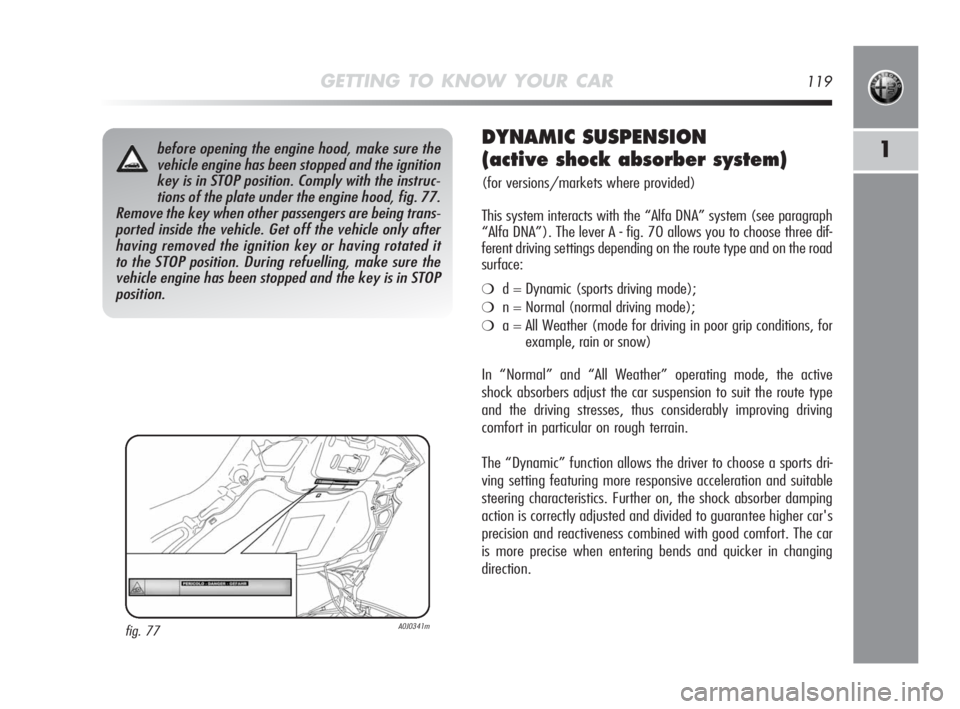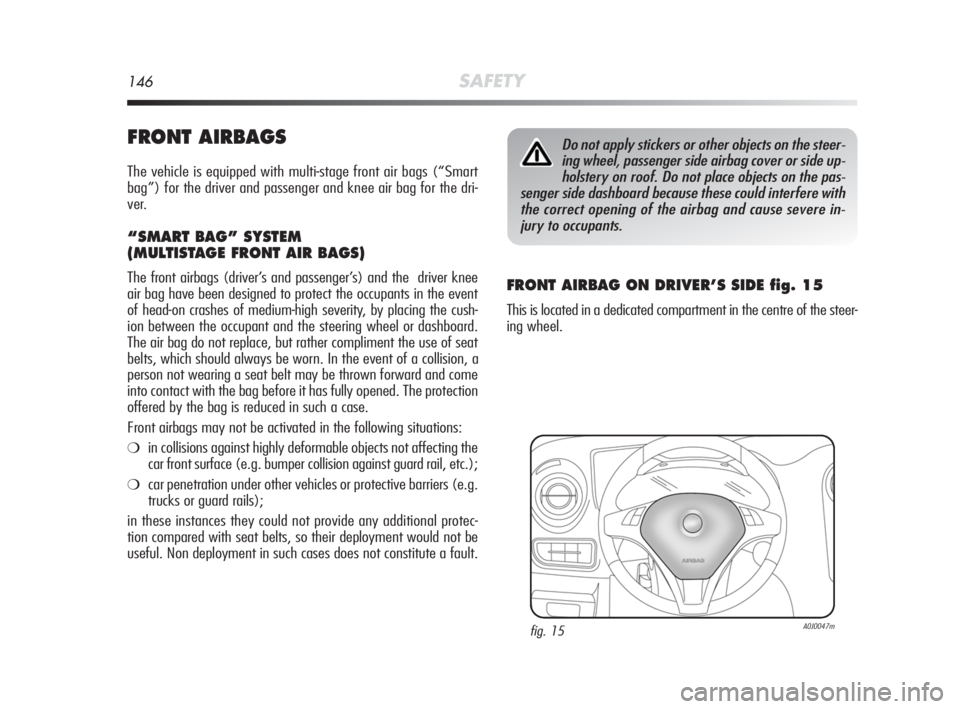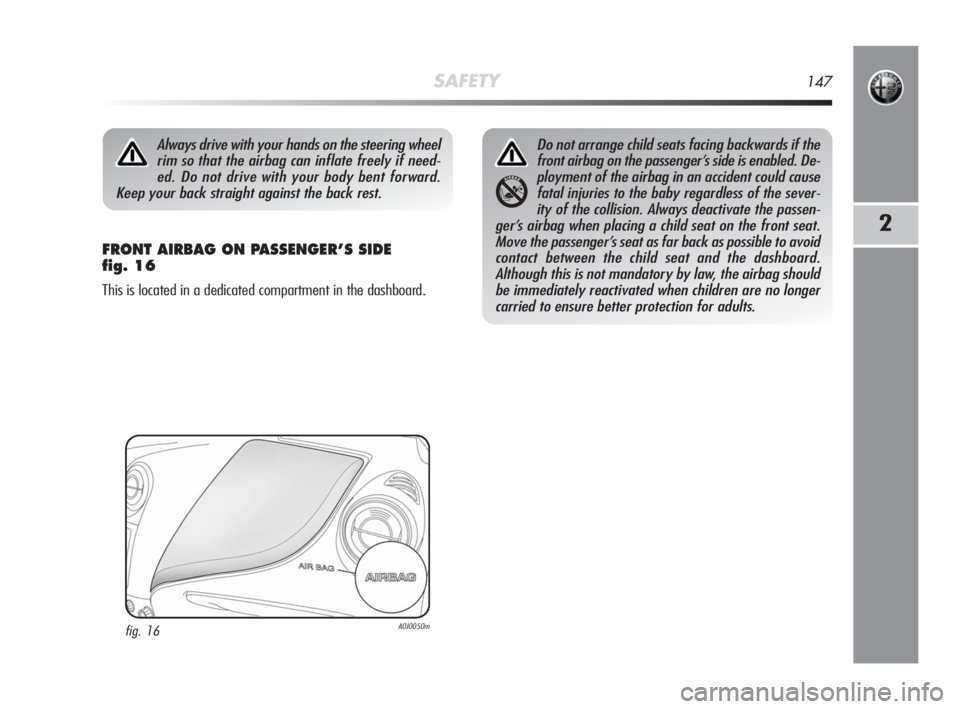steering Alfa Romeo MiTo 2010 Owner handbook (in English)
[x] Cancel search | Manufacturer: ALFA ROMEO, Model Year: 2010, Model line: MiTo, Model: Alfa Romeo MiTo 2010Pages: 262, PDF Size: 6.32 MB
Page 111 of 262

110GETTING TO KNOW YOUR CAR
BRAKE ASSIST
(emergency braking assistance)
This system, which cannot be excluded, recognises emergency brak-
ing (on the basis of the brake pedal operation speed) and allows
the braking system to react more quickly. The Brake Assist function
is deactivated in the event of VDC system failure.
MSR SYSTEM
This is an integral part of the ASR system which, in the event of
sudden gear downshifting, cuts in, providing torque to the engine
thus preventing excessive drive wheel drag which, specially in poor
grip conditions, can lead to loss of stability.
CBC SYSTEM
This function optimises the brake force distribution between the
four wheels (in order to make maximum use of the available grip)
when braking whilst cornering and the ABS system cuts in. This
improves stopping distances and above all vehicle stability when
cornering.
“ELECTRONIC Q2” SYSTEM (“E-Q2”)
The “Electronic Q2” system uses the braking system to create an
effect similar to a limited slip differential.
The front braking circuit, when accelerating around a corner, acts
on the inside wheel to increase the drive to the outside wheel (in-
creased load), dynamically and continuously distributing the torque
between the front drive wheels according to driving and road con-
ditions.
The system, combined with Mc Pherson front suspension, allows
for particularly effective and sporty driving.
DST SYSTEM (Dynamic Steering Torque)
This is an “active” vehicle control system. On road surfaces with
poor grip, it automatically corrects the steering and also controls
over-steer. This system applies torque to the steering wheel to in-
crease the feeling of safety, helping to keep the vehicle under
control and making the effects of the VDC system more discreet.
001-130 Alfa MiTo GB 2ed 23-12-2009 12:36 Pagina 110
Page 112 of 262

GETTING TO KNOW YOUR CAR111
1“Alfa DNA” SYSTEM
(Dynamic vehicle control system)
(for versions/markets, where provided)
This device allows three different driving modes to be selected by
operating lever A-fig. 70 on the central tunnel.
❍d = Dynamic (sports driving mode);
❍n = Normal (normal driving mode);
❍a = All Weather (driving mode for poor grip conditions, i.e. rain
and snow on the road)
The device also acts on the dynamic vehicle control systems (en-
gine, steering, VDC system, instrument panel).
fig. 70A0J0090m
DRIVING MODES
Lever A-fig. 70 is a one-way switch, i.e. it always remains in the cen-
tral position. The selected driving mode is indicated by the corre-
sponding LED coming on in the panel and by an indication on the re-
configurable multifunctional display, as illustrated below:
A0J0227mA0J0290m
Dynamic Mode All Weather Mode
Normal Mode
When “NORMAL” mode is selected, no messages or symbols are
shown on the display.
VDCandASR: Standard calibration
Steering wheel tuning: Standard calibration
DST: Standard control of the brakes coordinated with ABS
Standard control of side acceleration
Steering wheel compensation: a slight pulse on the steer-
ing wheel tells on the driver to make a better manoeuvre
Engine: Standard response
001-130 Alfa MiTo GB 2ed 23-12-2009 12:36 Pagina 111
Page 113 of 262

112GETTING TO KNOW YOUR CAR
ENGAGEMENT/DISENGAGEMENT OF
“Dynamic” MODE
Engagement
Move lever A-fig. 70 upwards (to the letter “d”) and hold in this
position for 0.5 seconds until the corresponding LED lights up or
the word “Dynamic” appears on the display (see diagrams). Up-
on release, lever A returns to the central position.
Disengagement
To disengage “Dynamic” mode and return to “Normal”, move
the lever as described above once again. In this case, the LED cor-
responding to “Normal” mode will light up and the words “Normal
engaged” will appear on the reconfigurable multifunctional display
(see diagram).
A0J0186mA0J1055g
A0J1052g
VDCandASR: Sporty calibration, intervention only in the event
of loss of control
Steering wheel tuning: Sportier calibration
DST: Standard control of the brakes coordinated with ABS
More control of side acceleration
Steering wheel compensation: a slight pulse on the steer-
ing wheel tells on the driver to make a better manoeuvre
Engine: Higher response speed + Overboost to maximise torque
speed (where provided)In the 1.4 Turbo Multi Air versions, selecting the "Dynamic" oper-
ation mode activates the turbocharger supercharging function (over-
boost): depending on the accelerator pedal position and for a lim-
ited time, the engine management control unit allows the system
to generate maximum pressure levels inside the turbocharger and
the engine torque can reach higher values than usual. This function
is particularly useful whenever maximum performance is required
for a short time (e.g. when overtaking).
IMPORTANT When the "Dynamic" function is used, during acceler-
ation the steering may shudder, which is typical of a sports setting.
001-130 Alfa MiTo GB 2ed 23-12-2009 12:36 Pagina 112
Page 114 of 262

GETTING TO KNOW YOUR CAR113
1
ENGAGEMENT/DISENGAGEMENT
OF “All Weather” MODE
Engagement
Move lever A-fig. 70 downwards (to the letter “a”) and hold in
this position for 0.5 seconds until the corresponding LED lights up
or the word “All Weather” appears on the display (see diagrams).
A0J0187mA0J1180g
Disengagement
To disengage “All Weather” mode and return to “Normal”, carry
out the same procedure described for“Dynamic” mode, moving
lever A-fig. 70 to “a”.
IMPORTANT NOTES
❍It is not possible to go from“Dynamic” mode straight to “All
Weather” mode and vice versa. You must always first go back
to “Normal” mode and then select the other mode.
❍If “Dynamic” mode was engaged when the engine was
switched off, the next time it is started “Normal” mode is au-
tomatically selected. If, however, “All Weather” or “Normal”,
was engaged when the engine was switched off, the selected
mode is maintained the next time it is started.
❍“Dynamic” mode cannot be engaged at speeds of above
110 km/h.
❍In the event of system failure or a fault with lever A-fig. 70,
no driving modes can be selected. The display will show a
warning message.
VDCandASR: Calibration to ensure maximum safety
Steering wheel tuning: Standard comfort
DST: More control of the brakes coordinated with VDC
Standard control of side acceleration
Steering wheel compensation: a slight pulse on the steer-
ing wheel tells on the driver to make a better manoeuvre
Engine: Standard response
001-130 Alfa MiTo GB 2ed 23-12-2009 12:36 Pagina 113
Page 115 of 262

114GETTING TO KNOW YOUR CAR
NoteThe engine automatic stop is allowed only after having run
at about 10 km/h, to prevent repeated engine stops when driving
at a very slow speed. The engine stopping is signalled by display-
ing the
Usymbol in fig. 71.
Engine re-starting mode
To restart the engine, press the clutch pedal.
SYSTEM MANUAL ACTIVATION/DEACTIVATION
To activate/deactivate the system, press the button fig. 72 on
the trim next to the steering wheel. When the system is deacti-
vated, the
Uwarning light in the instrument panel switches on.
For versions/markets, where fitted, a message plus a symbol on
the display may appear in the event of activation/deactivation of
the system.
START&STOP SYSTEM
(for versions/markets, where provided)
The Start&Stop system stops the engine automatically when the
vehicle stops and starts it again when the driver wants to resume
driving. In this way, the vehicle efficiency is increased, by reduc-
ing consumption, dangerous gas emissions and sound pollution.
The system is active every time the engine is started.
OPERATING MODE
Engine stopping mode
With stopped vehicle, the engine stops with gearbox in neutral and
released clutch pedal.
fig. 71A0J0279mfig. 72A0J0247m
001-130 Alfa MiTo GB 2ed 23-12-2009 12:36 Pagina 114
Page 120 of 262

GETTING TO KNOW YOUR CAR119
1before opening the engine hood, make sure the
vehicle engine has been stopped and the ignition
key is in STOP position. Comply with the instruc-
tions of the plate under the engine hood, fig. 77.
Remove the key when other passengers are being trans-
ported inside the vehicle. Get off the vehicle only after
having removed the ignition key or having rotated it
to the STOP position. During refuelling, make sure the
vehicle engine has been stopped and the key is in STOP
position.
fig. 77A0J0341m
DYNAMIC SUSPENSION
(active shock absorber system)
(for versions/markets where provided)
This system interacts with the “Alfa DNA” system (see paragraph
“Alfa DNA”). The lever A - fig. 70 allows you to choose three dif-
ferent driving settings depending on the route type and on the road
surface:
❍d = Dynamic (sports driving mode);
❍n = Normal (normal driving mode);
❍a = All Weather (mode for driving in poor grip conditions, for
example, rain or snow)
In “Normal” and “All Weather” operating mode, the active
shock absorbers adjust the car suspension to suit the route type
and the driving stresses, thus considerably improving driving
comfort in particular on rough terrain.
The “Dynamic” function allows the driver to choose a sports dri-
ving setting featuring more responsive acceleration and suitable
steering characteristics. Further on, the shock absorber damping
action is correctly adjusted and divided to guarantee higher car's
precision and reactiveness combined with good comfort. The car
is more precise when entering bends and quicker in changing
direction.
001-130 Alfa MiTo GB 2ed 23-12-2009 12:36 Pagina 119
Page 121 of 262

120GETTING TO KNOW YOUR CAR
ELECTRIC POWER STEERING
This only works with the key turned to MAR and the engine start-
ed. Power steering allows the force required at the steering wheel
to adapt to driving conditions.
The different power assistance modes can be selected via the d,n,a
positions of the“Alfa DNA System” lever (see paragraph “Alfa DNA
System”).
EOBD SYSTEM
(for versions/markets, where provided)
The aim of the EOBD system (European On Board Diagnosis) is to:
❍keep the system efficiency under control;
❍indicate an increase in emissions;
❍indicate the need to replace deteriorated components.
The vehicle also has a diagnostic connector that can be interfaced
with appropriate tools, which makes it possible to read the error
codes stored in the electronic control units together with a series
of specific parameters for engine operation and diagnosis. This check
can also be carried out by the traffic police.
IMPORTANT After eliminating a fault, to check the system com-
pletely, Alfa Romeo Authorised Services are obliged to run tests
and, if necessary, road tests which may also call for a long journey.
It is absolutely forbidden to carry out any after-
market operation involving steering system or
steering column modifications (e.g.: installation of
anti-theft device). This could badly affect performance and
safety, invalidate the warranty and also result in the non-
compliance of the car with approval requirements.
Before carrying out any maintenance operation
switch off the engine and remove the ignition key
to activate the steering lock. This is particularly im-
portant if the vehicle’s wheels are raised from the ground.
001-130 Alfa MiTo GB 2ed 23-12-2009 12:36 Pagina 120
Page 128 of 262

GETTING TO KNOW YOUR CAR127
1The T.P.M.S.system is not able to detect sudden tyre
inflation pressure losses (for example when a tyre
explodes). In this case stop the car, braking with
care and avoiding sharp steering actions.
Replacing the normal tyres with winter tyres and
vice versa requires the inspection of the T.P.M.S.
system, which should only be carried out by an Al-
fa Romeo Authorised Service.
The T.P.M.S. system requires the use of specific equip-
ment. Contact an Alfa Romeo Authorised Service to
find out which accessories are compatible with the
system (wheels, hub caps etc.). The use of other accessories
may affect the normal operation of the system.
When a tyre is removed, it is advisable to replace
the rubber gasket for the valve. Contact an Alfa
Romeo Authorised Service. Tyre and wheel fit-
ting/removal operations require specific precautions; to
avoid damaging or fitting the sensors incorrectly, tyre and
wheel fitting/removal operations should only be carried
out by specialists. Contact an Alfa Romeo Authorised Ser-
vice Provider.
Strong radio frequency disturbance can compro-
mise the correct operation of the T.P.M.S. system.
The driver is warned of this condition via a mes-
sage on the display. The warning message will go off au-
tomatically as soon as the radio-frequency noise ceases to
disturb the system.
Tyre inflation pressure can vary according to out-
door temperature. The T.P.M.S. system may tem-
porarily indicate insufficient pressure. In this case
check the tyre inflation pressure with the tyres cold and,
if necessary top up the inflation pressure.
001-130 Alfa MiTo GB 2ed 23-12-2009 12:36 Pagina 127
Page 147 of 262

146SAFETY
FRONT AIRBAGS
The vehicle is equipped with multi-stage front air bags (“Smart
bag”) for the driver and passenger and knee air bag for the dri-
ver.
“SMART BAG” SYSTEM
(MULTISTAGE FRONT AIR BAGS)
The front airbags (driver’s and passenger’s) and the driver knee
air bag have been designed to protect the occupants in the event
of head-on crashes of medium-high severity, by placing the cush-
ion between the occupant and the steering wheel or dashboard.
The air bag do not replace, but rather compliment the use of seat
belts, which should always be worn. In the event of a collision, a
person not wearing a seat belt may be thrown forward and come
into contact with the bag before it has fully opened. The protection
offered by the bag is reduced in such a case.
Front airbags may not be activated in the following situations:
❍in collisions against highly deformable objects not affecting the
car front surface (e.g. bumper collision against guard rail, etc.);
❍car penetration under other vehicles or protective barriers (e.g.
trucks or guard rails);
in these instances they could not provide any additional protec-
tion compared with seat belts, so their deployment would not be
useful. Non deployment in such cases does not constitute a fault.
FRONT AIRBAG ON DRIVER’S SIDE fig. 15
This is located in a dedicated compartment in the centre of the steer-
ing wheel.
Do not apply stickers or other objects on the steer-
ing wheel, passenger side airbag cover or side up-
holstery on roof. Do not place objects on the pas-
senger side dashboard because these could interfere with
the correct opening of the airbag and cause severe in-
jury to occupants.
fig. 15A0J0047m
131-152 Alfa MiTo GB 2ed:131-152 Alfa MiTo GB 23-12-2009 12:37 Pagina 146
Page 148 of 262

SAFETY147
2
FRONT AIRBAG ON PASSENGER’S SIDE
fig. 16
This is located in a dedicated compartment in the dashboard.
Always drive with your hands on the steering wheel
rim so that the airbag can inflate freely if need-
ed. Do not drive with your body bent forward.
Keep your back straight against the back rest.
fig. 16A0J0050m
Do not arrange child seats facing backwards if the
front airbag on the passenger’s side is enabled. De-
ployment of the airbag in an accident could cause
fatal injuries to the baby regardless of the sever-
ity of the collision. Always deactivate the passen-
ger’s airbag when placing a child seat on the front seat.
Move the passenger’s seat as far back as possible to avoid
contact between the child seat and the dashboard.
Although this is not mandatory by law, the airbag should
be immediately reactivated when children are no longer
carried to ensure better protection for adults.
131-152 Alfa MiTo GB 2ed:131-152 Alfa MiTo GB 23-12-2009 12:37 Pagina 147